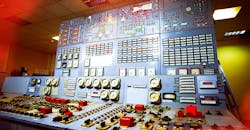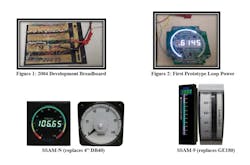Analog Obsolescence: Effects and Solutions
ABSTRACT
Main control rooms across prominent American industries are facing a worsening obsolescence issue due to discontinued, 1960s-era analog and 1980s-era digital panel meters. As manufacturers for these devices have dropped out of the market, replacement units are increasingly difficult to find. The Nuclear and Military industries are being hit particularly hard, as some meters are only available as rebuilds from resellers and cost upwards of $20,000 each for Class 1E instruments versus $200 for a commercial-grade replacement. Additionally, security personnel and Cyber Security (CS) regulation requirements could increase the cost into the millions. On top of all these facets, add to it the recent U.S. executive order against components manufactured in China, and, as we used to say at NASA, “Houston, we have a problem!”
The problem is not limited to obsolescence. Operational inefficiency due to analog meter inaccuracy, parallax, operator errors, and stuck needles also impacts plant profitability. In consideration of all expenses, modernization can yield a slow or virtually non-existent ROI. This paper will address the effects of obsolescence and its possible solutions across the Nuclear, Military, Commercial Maritime, and Water Treatment industries.
INTRODUCTION
Nuclear I&C Rooms: In the beginning, nuclear energy proved to be the most powerful, reliable, and clean method of profitably producing energy. The industry, led by the United States, blossomed into over 430 power plants globally with 93 active facilities in the U.S. Today, there are over 35 plants under construction in other countries and 3 pending in the US. Over 350 of these plants are approaching decommissioning or re-commissioning in the next 2 to 3 decades, as they are currently over 30 years old. Most of the plants contain an average of 500 meters, comprised of nearly 80% analog meters using technology developed in the 1890s.
When these plants were built, only analog meters were available. They were economical and easy to use and read. Does this technology still make economic and safety sense? Inaccuracies, operator parallax errors, and unreliability have forced nuclear power plants to implement safety protocols in their control rooms resulting in operation below optimum efficiency. Can digital technology come to the rescue?
In the 1980s a new technology was available to digitize main control rooms to increase accuracy, safety, and profitability. The upgrade required a heavy investment in time and money to implement, as the digital instruments were not FF&F compatible with existing analog signal powered metering. The wiring, mounting, and power required replacement, in addition to operators being retrained. The process took years of planning, testing, and agency approvals, as well as compliance with cybersecurity regulations. The final costs were between tens and hundreds of millions of dollars in capital and losses resulting from outages; it took years to recoup ROI.
Military/Commercial Maritime Vessels: While it is difficult to calculate the vast number of obsolete instrumentation populating the Bridge & Control rooms of vessels and ships within both of these industries, it is safe to estimate that figure is in the millions and represents an urgent need for modernization. Depending on the existing mechanics of each vessel, the popular Flat Screen integration option is the most appealing but necessitates a substantial investment of time and resources for new panels, computers, and wiring, as well as operator training not being affordable by the private commercial owners.
Vessels for military use receive better support for modernizing their instrumentation due to the tax revenue and lobbyist effort attached to federal contracts, but this still constitutes the lengthy investment outlined above when the ship is in port for upgrade and maintenance and does not produce an immediate ROI.
Water Treatment Facilities: The majority of plants within the industry use analog meters for roughly 80% of their operatorial infrastructure, without much leftover in their maintenance budgets for renovation. Naturally, this eliminates the Flat Screen and Computerized Automatic Process Control (APC) option. Given this limited agency, treatment plants have largely resorted to replacing the analog meters as they fail or in a planned outage, with “Plug & Play” digital equivalents that come equipped with serial I/O for future Data Acquisition System (DAS) use. This approach eliminates the expense of new panels, wiring, and downtime necessitated by the more popular Flat Screen or DAS options.
HOUSTON, WE HAVE A PROBLEM!
This study focuses on 20+-year-old nuclear power plants that desperately need FF&F (P&P) replacements for obsolete analog and digital meters that can be installed in a regular maintenance cycle.
- Original 1980s Class1E Analog and Digital replacements are non-existent as the replacement market doesn’t justify operating expenses of manufacturers.
- Class 1E FF&F rebuilt replacements are expensive and hard to find. Plants must be willing to settle for rebuilt replacements with 6+ months of delivery time.
- Digitizing the Main Control Room with automatic process control (APC/SCADA) and Flat Screen monitors requires 3 to 5 years to build, can cost over $200 million (+interest), and it may take 2 to 4 years to receive NRC approvals. While ideal, this is unrealistic as it is only affordable by new installations (Ref.: INL, NN, NPJ, Oconee NPP). I call it the “Heart Transplant”
- A lower cost and faster turn-around option is available with a DAS (Data Acquisition System); but these options still require a new I&C Room, 2 to 3 years to implement, and approximately 2to 3 years for NRC approval at over $50 million in expenses, plus another $20 million+ in CS compliance expenses without R.O.I.
- The latest advances in digital meter technology do not solve the nuclear power plant industry’s problem of compliance with NEI’s Cyber Security Mandate (NEI 08-09); further exacerbating the problem for plants by increasing expenses without any R.O.I.
THE SOLUTIONS?
“Dr. Fest, as much as we like your NTM Meters, we cannot afford them because the high cost of implementing Cyber Security Protection per NRC (NEI08-09) mandate,” is what the I&C manager of North Anna NPP in the USA said to me when I held a Lunch & Learn session. “What we need is the NTM without Cyber Security Liability for our old Plants,” he continued.
Back to the drawing board. I had to design a replacement meter with the following features:
- 100% Solid State design with analog and numerical colored display
- 100% Signal & Externally powered using the same housings & wiring as obsolete meters
- Eliminate the “Stuck Needle” syndrome (Fail Safe)
- Only use “generic” components for 40+ years life of design (Mil-Std. requirement)
- “One Size Fits All” design to eliminate/reduce spares in inventory, especially for Maritime applications where the ship cannot return to port for an extended period of time.
- 101 segment bar graph (for 1% accuracy & resolution) and 4-1/2 digit display for 0.01% accuracy & resolution for high HMI.
NECESSITY, THE MOTHER OF INVENTION
I knew I could help the Nuclear Power Industry overcome the obsolescence and CS problems. In my lab, I resuscitated an old all hardware 2004 project (Figure 1) which had been abandoned in favor of a microprocessor-based design (CS vulnerable) that was CS exempt by design and was powered by the popular 4-20mA current loop and/or AC/DCV, AC/DCA, AC/DCW & Hz. (like the obsolete analogs). But how could I replicate the Automatic Tricolor (RGB) Bar graph of the NTM without a processor to avoid NEI08-09? I used pure white LED bar and a customized multicolor scale plate per customer’s needs.
This served two purposes: mimic the Safe, Caution & Danger color zones on the SSAM using the “One Size Fits All” to eliminate unnecessary spares in inventory by only changing the “scale plate” on the SSAM. Secondly, the Fail-Safe problem was solved by our patents #1,022,405 and 9,054,725 that use the parasitic energy of the signal to store it and power the SSAM when the signal or power fails, notifying the user visually and via alarm outputs. All 100% signal powered. I call this the Pace Maker Solution.
TWO YEARS LATER:
The final result is a Nuclear Class1E or Mil-Spec 100% hardware only (Cyber Security Exempt) meter, that’s powered by the signal or any AC/DC signal capable of producing over 5mW of energy. This new meter also comes with built-in Adjustable Alarm Outputs (MOSFET, SSR, Reed Relays), 4-20 mA output (retransmission), and contains a USB serial output. The SSAM replaces obsolete analog or digital meters 100% Form, Fit & Function (Plug & Play) at a fraction of the cost of rebuilt instrumentation.
THE “ONE SIZE FITS ALL” PLUG & PLAY APPROACH:
THE ECONOMIC FACTOR (Heart Transplant vs. Pace Maker?)
I love innovations. Automatic Process Control (APC/SCADA) and or Flat Screen (DAS) is ideal for I&C rooms across a host of industries as long as their plant age and market constraints are low. But for a plant with a limited operating life expectancy and under strict regulations that would require years and innumerable expenses to modernize, the APC, DAS, and Flat Screen options are akin to performing a Heart Transplant on an old man (like me). The SSAM is a Pacemaker.


